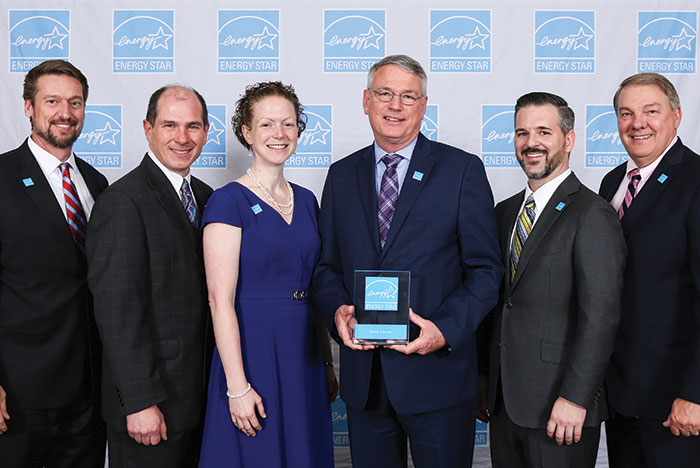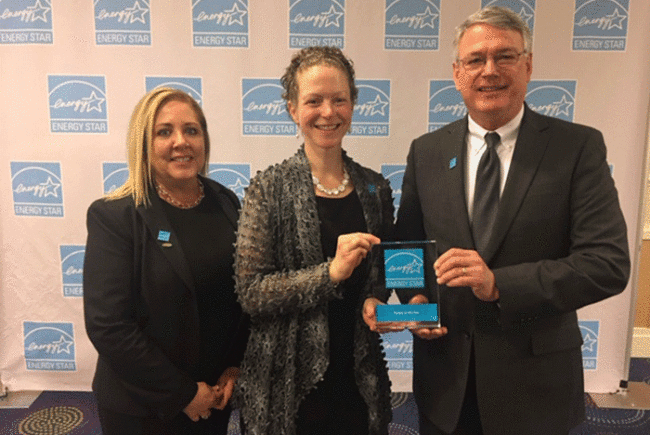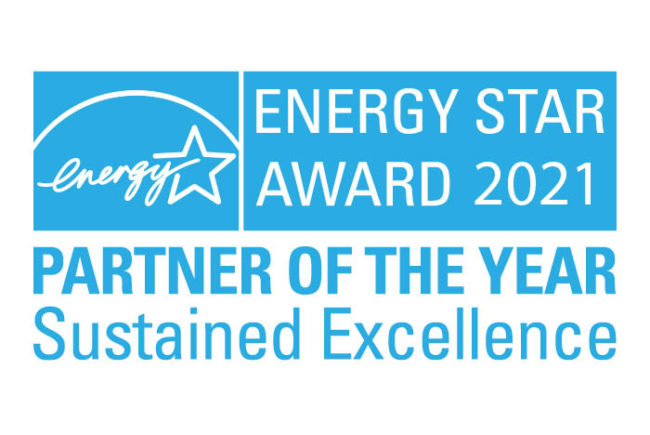
ASHE leaders accepting the Partner of the Year award during a ceremony in Washington, D.C., are (from left) Bradley R. Taylor, ASHE president-elect; Clark Reed, the EPA’s national program manager for Energy Star commercial buildings; Carolyn Snyder, director of EPA’s Climate Protection Partnerships Division; Russell Harbaugh, ASHE president; PJ Andrus, ASHE executive director; and Terry Scott, ASHE immediate past president.
Citing the success of the Energy to Care program for hospitals and the American Society for Healthcare Engineering’s (ASHE’s) overall commitment to environmental sustainability, the Environmental Protection Agency (EPA) named ASHE a 2017 Energy Star Partner of the Year — Energy Efficiency Program Delivery Award winner.
ASHE has notched “some really amazing accomplishments,” points out the EPA’s Clark A. Reed, the national program manager for Energy Star Commercial Buildings.
First, the Energy to Care program, an energy-benchmarking platform for health facilities that integrates the EPA’s Energy Star Portfolio Manager benchmarking tool, has grown dramatically since ASHE revamped and renamed the program a few years ago.
“The number of participants in Energy to Care has increased by more than 60 percent since 2010,” says Kara Brooks, LEED AP BD+C, ASHE’s sustainability program manager, who notes that more than 2,500 health facilities are enrolled in the program. Of those health facilities, 194 have an Energy Star score of 75 or higher.
While Portfolio Manager provides the tools to measure and weather-normalize energy data, Energy to Care includes a user-friendly dashboard and communication platform that makes it easier for hospitals and other medical buildings to compare their own energy performance to that of similar facilities. The program also facilitates energy conservation competitions among hospitals in a region or among competing regions such as the ASHE chapter competitions that now take place across the country.
This year, the ASHE Energy to Care Chapter Challenge included 12 state chapters that competed with one another based on energy-reduction percentages.
“ASHE has done a great job in recruiting participants and getting everybody to become more energy efficient through this competition,” Reed emphasizes.
“I think the biggest incentive to being involved with the challenge is the camaraderie that comes from it,” adds Jonathan Flannery, CHFM, FASHE, FACHE, ASHE’s senior associate director of advocacy. “The challenge also makes you feel that you are part of a much bigger picture — that we’re all working together to reduce energy [use].”
In addition, says Flannery, the potential bragging rights that come with winning the competition appeal to the participating chapters. “Everyone would like to be able to say, ‘We are the best.’”
A hallmark of the Energy to Care program is that it honors hospitals and other health facilities for improvements in energy efficiency — in contrast to the EPA, which recognizes health facilities in the top quartile (those with Energy Star scores of at least 75).
To receive an Energy to Care Award, “you need to have a 10 percent improvement or reduction in energy usage,” Flannery explains. “And then for every 5 percent reduction after that, you are recognized.”
At this month’s ASHE Annual Conference & Technical Exhibition, for instance, Barnesville (Ohio) Hospital is being honored as the 2017 Energy Champion for demonstrating strong leadership in becoming a more energy-efficient facility and using saved resources to support patient care. In addition, dozens of hospitals that have earned an Energy to Care Award for slashing energy use also are being recognized (go to www.energytocare.org to learn more).
The main reason ASHE received the Energy Star Partner of the Year award, however, is that Energy to Care achieves results. Participating health facilities reduced their energy consumption by a total of 75 million MMBtu’s during the six years ending in December 2016, equating to $127 million in savings.
Carolyn Schierhorn, a freelance writer based in Wheaton, Ill., specializes in health care- and construction-related topics.






